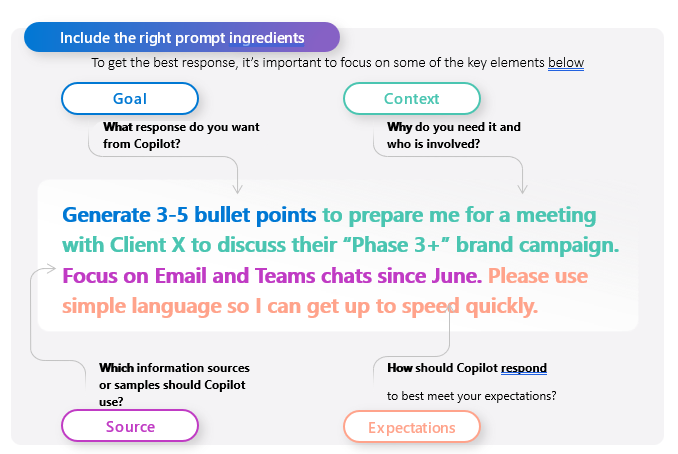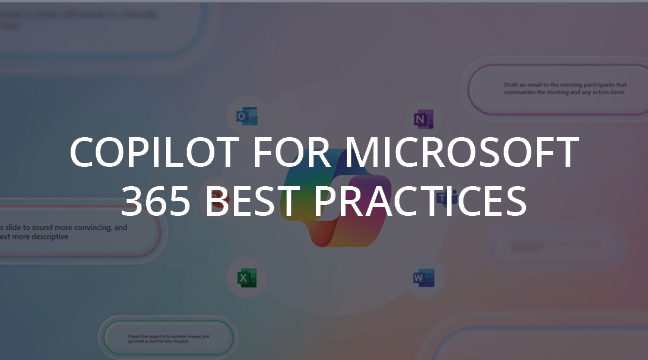Copilot for Microsoft 365 Best Practices
We have been working with several customers over the past few months as they have been planning for or running pilots of Copilot for M365 in their organizations. Like every Microsoft solution, it requires planning for implementation and adoption and its use should be aligned with the overall business strategy and goals. We have many lessons learned that we have been sharing with our clients; we have found a few key areas that are critical to focus on for better adoption and overall experience:
1 – Learning Effective Prompting. Often, end users assume that working with Copilot will be the same experience as working with Chat GPT. However, prompting with Copilot is more of an art and a science. You want to set the stage clearly for how you want Copilot to help you providing relevant details with as much context as possible, specify any information sources and data that Copilot should use, and set expectations as to how you expect Copilot to respond (for example, provide the results as a table). From there, you often need to iterate and experiment to find the right prompt ingredients for your desired responses. This is also why it is helpful to create Communities of Practice with your users so that they can share effective prompting strategies for your organization.

2 – Ensure users have access to the right data they need to use Copilot – and that they don’t have access to information that they shouldn’t be using. Many of our clients have proactively worked with us on readiness over the past few months to do some assessment of their content and security waiting for Copilot to be more generally released. However, now that Microsoft has changed their licensing requirements so that more customers can purchase Copilot, some are jumping on the opportunity to try it out without having done that due diligence upfront. Often, they are quickly finding users are getting responses that are including sensitive, confidential, or stale data within the organization. In those cases, we have been helping them go back to review security settings and often leveraging tools like Purview to ensure the proper sensitivity labels and retention policies are in place.
3 – Planning for your pilot and broader roll out strategies. Copilot relies on the Semantic Index to work, and it works much better overall when more people are using Copilot in the organization. However, you want to be strategic as to who is using it in your pilot group so that you can get a broad set of feedback from use in several of the Office tools while also accelerating the most value in the shortest amount of time by having people working with similar data in your pilot. This also starts to help with adoption where people can get excited and share experiences as a group. Many end users are excited to use Copilot and see the potential it has to help them become more productive, creative, and efficient at their work – however, not everyone feels comfortable about using AI. So, you also want to be intentional about training, end user engagement, and sharing best practices that have been found from your pilot.
These are just a few of the common best practices and lessons learned from our work with Microsoft and initial adopters in our client base. I would love to set up some time to discuss further to provide additional examples or explore these in further detail. Check out our Copilot for Microsoft 365 Readiness Workshop or join us for an upcoming briefing.
Rachael Narel
Rachael Narel is Interlink's Employee Engagement and Productivity Practice Lead focused on helping our customers leverage technology, process, and people practices to successfully achieve organizational outcomes. Her practice optimizes usage of several Microsoft tools including Viva, Copilot, SharePoint, and Power Platform. Rachael has over 20 years of experience working in the IT and software fields in both team and leadership roles. Her diverse background includes organization development, change management, strategic planning and process improvement, user adoption, and training. Rachael has a PhD in Organization Development and a Master of Science in Management and Organizational Behavior.



